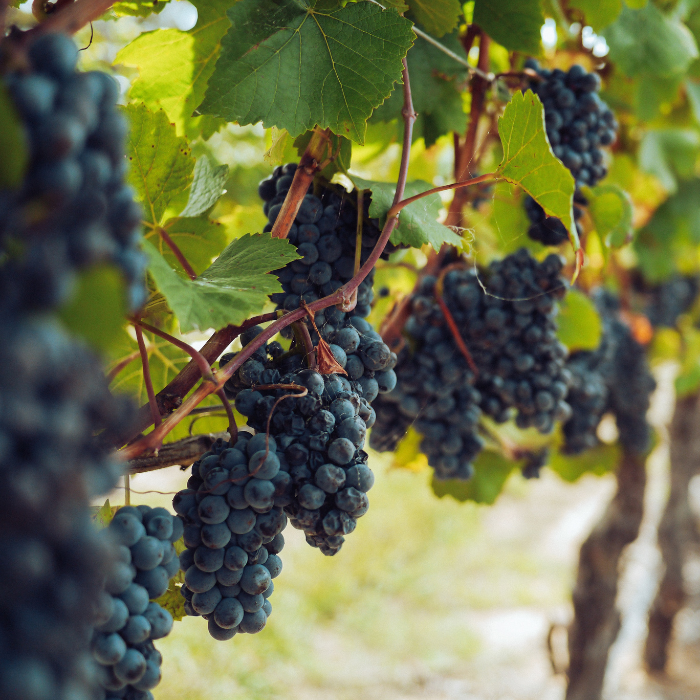How To Make Wine from Grapes
If you’re wondering how to make wine from grapes, I’m here to share some winemaking secrets.
Great wine starts in the vineyard, so you’ll should start with fresh, ripe grapes. The grapes should taste delicious before you even begin, a perfect harmony of delectable grape sugars and lively acidity. Presumable any old ripe grapes will do, since wine is simply the conversion of grape sugars to alcohol by yeast.
But I can’t vouch for the results if you use Thompson seedless from the grocery store. If you’re curious about how to make wine from grapes with personality, you’ll need to discover grapes with terroir and a sense of place.
What is a “sense of place”?
"A sense of place," it's the one of the greatest compliments a wine aficionado can bestow upon a wine maker.
Encompassing more than the French word terroir, for New World wine lovers, "a sense of place" means that a wine tastes like the culmination of mindful farming, precise harvest, watchful fermentation, and conscientious aging.
This is how to make wine from grapes that sing and taste like sunshine. Lovingly crafted, such wines stand in defiant opposition to the insipid, mass-produced, hot, over-oaked drek lining the shelves at Vons.
If you can taste fruit, warm sunshine, wet earth, clean rain, and a complete palate of complimentary, wonderful, ancillary flavors then you know firsthand what elevates a "sense of place" wine from alcoholic crutch to poetic muse.
Typically, “sense of place” wine is vinified from grapes in the Vitis vinifera family, grapes with noble DNA heritage, hailing from Old World growing regions like France, Spain, and Portugal.
If you’re considering how to make wine from grapes, the first step is deciding which varietal to crush, for example, cabernet sauvignon versus syrah versus chardonnay. Each grape varietal is different and results in a different kind of wine.
The next step to tackle in how to make wine from grapes is harvest itself.
The process of how to make wine from grapes begins…
At harvest.
And I’m the first to admit that these gauzy visions and “sense of place” mumbo jumbo are poetic aspirations, begging to be balanced by the cold, hard facts- numbers and data.
UC Davis tells us in no uncertain terms that “none of the flavor and aroma compounds [in the grape berries] are directly correlated with sugar and acidity (Bisson).”
In other words, if you’re wondering how to make wine from grapes, you can’t reliably predict the amount of sugar and acid in a grape by taste test alone - you need to measure it.
Many parameters can be used to assess berry ripeness, but the most common triad is °Brix, pH, and TA (“titratable acid”). Degrees brix measures the soluble solids in the grape juice. Even at its ripest, a grape is still 80% water by weight, with grape sugar rounding out that last 20%.
Over the course of the growing season, the leaves hang out in the sunshine, working the spring and summer photosynthesis, generating sugar to transport to the fruit. As the berries accumulate more and more sugar, they sweeten up until they’re ready for picking. To make wine from grapes requires understanding how we measure sugar.
We can use different tools, like a hydrometer or refractometer, to measure how much glucose and fructose reside inside the grape and that value is the °Brix. For red wines, harvest-ready fruit ranges from 22-27 °Brix. I give a range since °Brix varies with temperature, vine location, sunlight, and across innumerable, individual vineyard practices.
The “right” number is also dictated by the desired wine style. Even still, we can make some interesting generalizations about °Brix. Usually, to make wine from grapes with higher brix results in wine with more varietal character, which taste testers seem to prefer in blind trials.
Ann Noble studied this. She made 3 different Zinfandels: low, medium, and high alcohol wines, made from grapes with low, medium, and high °Brix. Here is what she found: in all rated attributes, the high alcohol wines from the ripest grapes were ranked first.
In this study, making wine from grapes with high sugar resulted in a wine with a greater intensity of bitterness, berry and black pepper flavors, and viscosity.
Ann Noble, UC Davis
In her study, the flavor attributes and varietal character are strongly correlated with sugar accumulation. It would appear that to make wine from grapes with more sugar=better wine, but caveats must be disclosed.
Grape berries don’t hoard sugar indefinitely; eventually grape sugar peaks, and then even drops. By that point, you’ve missed the optimal window for harvest, and fruit quality declines. To make wine from grapes that are either too ripe or not ripe enough results in sub-optimal wine.
For Instance…
As the fruit ripens, berry flavors transform from green vegetal tones into red fruit (strawberry, cranberry, apple) to black fruit (blackberry, plum, cassis) and finally to jammy date/raisin.
To make wine from grapes well means aiming for the sweet spot, enough sugar and flavor development before hitting pureed prune territory.
Secondly, the more sugar in the berries, the harder the yeast must work to churn it into alcohol. To make wine from grapes with excessive sugar levels is equally problematic.
When the sugar is too high, sometimes the yeast hit the wall and crap out. They die, and you’re left with sweet dreck, which is not only stylistically unacceptable for our wine portfolio but also drastically increases the likelihood of bacterial spoilage.
To make wine from grapes requires balancing sugar levels with acidity. The next two harvest parameters are closely intertwined: pH and TA. Both contribute to the tartness of the finished product, which gives the wine lively zestiness and focus, qualities of supreme importance when pairing wine with food.
To make wine from grapes with ample acidity is good. Low acid wines are bland and flabby and age poorly. Low acid wines are also more susceptible to microbial infestation and spoilage. Grape berries begin their lives as small, hard, green acid balls - think Sour Patch Kids.
To make wine from grapes like these would be challenging! Yet over summer, sugar increases and acid drops. This is due to respiration (the berries metabolize their malic acid for energy) and dilution (the berries get bigger, and acid is tamed by water).
In the real hot spots, like California’s Central Valley, the poor, scorching berries respire their malic acid a lot faster, so acid levels are much lower overall, and pH is higher. If you’re wondering how to make wine from grapes like these consider the boxed wine in grocery stores.
These grapes have high sugar (from abundant sun) and low acid; they’re used to make bulk wine. Generally, the increase in sugar parallels the rise in pH (as acid drops). When I harvest grapes for Bruliam Wines, I like to see acid (“TA”) as high as 7 g/L and pH=3.2-3.5.
If you’re curious how to make wine from grapes optimally, there are even fancy formulas that combine the TA, pH, and brix into one equation to generate one optimal ripeness parameter, like brix x (pH)2 , brix/TA, and brix x pH. Unfortunately, none perfectly or reliable predicts the optimal date for harvest.
Compressing the complexity of berry ripeness into a single variable for selection/ prediction of an optimal harvest date is not only incredibly reductive but also inconclusive. To make wine from grapes requires being out in the vineyard, tasting, tasting, tasting, with a holistic approach to the vine.
Consider for a moment an over-cropped vine - one with too many grape clusters. Since all of those grapes share the same finite amount of sugar, the amount of sugar per berry is low, but so it the acid. Plug your numbers into the equation and the ratio is acceptable, but to make wine from grapes like this results in mediocre wine.
Alternatively, return to those Central Valley grapes. “Optimal ripeness” is achieved well before the maximal °Brix, since the longer the berries hang on the vine, the more the acid drops. You see, harvest is the final chain that ties viticulture to enology.
If you want to understand how to make wine from grapes in your vineyard, you need to recognize what ripeness means for your site.
Once picked, you’ve sealed their fate. The berries are delivered from the farmer to winery, with whatever fruity essence and flavor shapes the finished wine. While vintners can adjust acid levels and correct for defects in the laboratory, a grape deficient in flavor will never generate delicious wine.
And while a farmer cannot control the weather or predict an onslaught of unwanted pests, the harvest date can be selected and controlled. If you want to learn how to make wine from grapes, the work begins in the vineyard.
Speaking of Vineyards…
Come swing by Bruliam Wines for a tasting. While you’re trying our pinot noir or zin, we can talk all about making wine from grapes.







